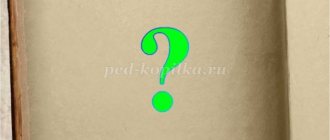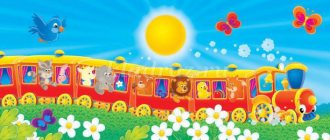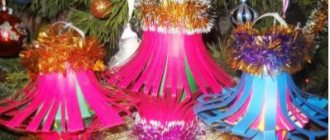Purpose of the lesson
Teach children to form the number seven from two smaller numbers; fix the names of the days of the week; practice composing the number 7 from units; continue to teach children to increase numbers within 10 by one.
Materials
For the teacher: numbers (2-3 sets), chips. For children: “Math set”, colored pencils.
Progress of the lesson
Guess it
Mom bought six red and blue balloons. There were more red balls than blue ones. How many balls of each color could there be? (7 and 5, 2 and 4, or vice versa.)
Sitting at the table
In front of the children are mugs of two colors. The teacher gives the task to count seven circles of the same color and put them in a row. Then asks the children to think about how they can make the number seven from two smaller numbers.
— Lay out in order all the variants of the number seven on your tables.
Once the children have finished, ask them again to tell how the number seven can be made from two smaller numbers.
Note. While laying out the composition of the numbers, check that the children are completing the tasks correctly.
Ask individual children which version they are laying out now, what the previous one was, and what version of the number composition they will lay out next.
Try asking questions in different ways. For example: “You have three red circles laid out in this row, how many yellow ones will you put?” or “You will put two red and three yellow circles, but how many more yellow ones should you put?”
Let's play
“Which hand has how much?”
"Live Week"
It is advisable to construct a “week” from any day of the week.
Sitting at the table
First, the teacher asks the children to lay out a series of numbers from 0 to 10, then count seven pencils and put a number that will show how many pencils they have counted.
Questions for children:
how many pencils did you count?
what number is next to the pencils and why?
How many pencils did you put aside? (One red, one yellow, one blue, one green, one brown, one black, one cyan.)
increase this number by one and “write” it down.
Children carry out the teacher's assignment. Before them is a “record”:
7+1=8
The teacher invites the children to read the “record.” Children read: “Seven plus one makes eight.”
The teacher suggests increasing the number by one and making a “record.” After completing the task, the children read the “record.”
Tips for a teacher
The game “Live Week” can be played outdoors, but only after the children have rested.
In your free time, practice with those children who have difficulty making shapes from triangles.
Together with your children, make a feeder from a bag and hang it on a tree. The feeder will be needed in the next lesson.
Tell parents what the children did during the lesson and suggest that they practice counting at home.
Recommendations for parents
The game “How much is in the other hand?” They play together. For the game, prepare small objects so that they can fit in the child’s hand, for example, beads.
Rules of the game.
The adult says to the child: “I have six beads, in my right hand there are three beads (shows). How much is in the left?” If the child answered correctly, switch roles, let him hide the beads, and you answer his questions. At the same time, you can intentionally make mistakes and correct them as the game progresses.
Summary of GCD for children of the preparatory group “Composition of the number 5”
Natalya Khokhlova
Summary of GCD for children of the preparatory group “Composition of the number 5”
Tasks
Educational: introduce children to the composition of the number 5, teach how to decompose the number 5 into two smaller ones, and form a whole from two smaller ones.
Correctional: develop attention, thinking, fine and gross motor skills.
Educational: to cultivate a culture of behavior and interest in mathematical games.
Materials: 5 circles (red on one side, blue on the other) - for each child. A set of numbers from 1 to 5, signs “+”, “=” for each child, number houses of the number 5, five colored pebbles, game coins in denominations of 1, 2, 3, 4, 5, stickers.
Organizing time
Children receive from the teacher a card with a picture of numbers and are lined up in order. The teacher asks the children to remember who has what number, after which the cards are removed.
- Guys, I have a riddle for you. If you guess it, you will find out what number we will be meeting with you today.
Baby Lena on hand
Loves to count fingers!
She, surprisingly,
Every time it comes out... (five).
- That's right, five. And I'll tell you a secret. Today we will introduce you to the number five. Let's find out how to decompose it into two smaller numbers, and how to get a whole from two smaller ones.
(There are five red circles on the board).
- What do you see on the board? (geometric shapes, circles).
- How many circles are there in total? (five).
- How did you find out? (counted).
- Place circles on the table in front of you just like on the board. How many laps do you have? (five).
- What number can be used to indicate this quantity (the number five).
(Find the number 5 and place it above the figures).
- And now I suggest you turn the last circle over to the other side. (turn the circle blue side up).
- How many circles are there? (five)
(They find out that the number of circles has not changed, but the number five was obtained in a different way).
— How many red circles? (four). Label this quantity with a number.
— How many circles are blue? (one). Label this quantity with a number.
- So five is what and how much? (Five is 4 and 1)
(Mathematical notation 4+1=5; reading notation.
(We carry out similar work until we turn over all the red circles).
Fizminutka
And now, guys, stand up,
They quickly raised their hands up -
To the sides, forward, backward,
Turned right, left,
Sit down quietly and get back to work!
(The teacher invites the children to move the residents into number houses.) House of number 5 is an exercise.
Didactic game “Colored pebbles”
— I have 5 stones. I will divide them in my hands and show one palm. Guess how many pebbles are in the other palm. Why? (The game is repeated several times, the leader can be a child)
— Guys, please tell me, have you learned to make the number 5 from two smaller ones? I want to make sure of this. I suggest you play a game called “Shop”. The rules are simple.
Game "Shop"
You receive several game coins. I suggest you buy stickers, they cost 5 rubles. You need to give me 2 such coins so that together you get 5. Then the sticker is yours.
(Children receive stickers, the lesson ends. Before the children return to the group, the teacher asks them to remember who received which number at the beginning of the lesson and invites the children to line up in reverse order).
Abstract of the open GCD in the preparatory group for the OO "Cognition". Composition of number 7
Abstract of educational activities for children 6-7 years old on the educational program “Cognition” (mathematical and sensory development) “Composition of the number 7”
Goal: to consolidate knowledge about the composition of the number 7. Objectives: 1. Educational: • To consolidate the ability to decompose the number 7 into two smaller numbers; • Consolidate knowledge about the days of the week, the colors of the rainbow; • Strengthen the ability to use a ruler to draw segments; • Strengthen the ability to perform graphic dictation under dictation; • Learn to color pictures using numerical color notations; 2. Developmental: • Develop spatial and logical thinking; • Develop attention, memory, speech, imagination; • Develop the ability to evaluate your work independently; • Expand children's horizons. 3. Educational: • Cultivate a sense of compassion, a desire to do good; • Develop the ability to listen to other children without interrupting. Didactic material: 1. Ballpoint pens, colored pencils, rulers, glue stick for each student; 2. Checkered sheets (2 pieces) for each student; 3. An envelope with painted buckets and a set of colored paper fish for each student; 4. A4 sheet of paper with an image of an octopus for each pupil; 5. A4 sheet with an image of ladybugs for each pupil; 6. Color by number sheet for each student; 7. Self-assessment sheet “Seven Flowers” and a set of seven petals for each student; 8. Illustration from the fairy tale “Snow White and the Seven Dwarfs”; 9. Illustration “Rainbow”; 10. Illustration “Nuts”; 11. Image of a ladybug. Progress of educational activities: Teacher: Hello, guys! Look, guests came to our lesson today. They want to see what you can do and what you know. Therefore, we need to try and not be distracted. Introduction to the game situation: That day has come! We are not too lazy to study. Let's hold hands tightly and smile at each other. We will look at the guests, It will immediately be more fun! Now let's face it - we got up early today. To come to kindergarten to show what we know! Teacher: Guys, you are already quite big and in a few months you will go to school. And which of you will answer my question: “How old will each of you be when you go to school in first grade? Children: answers. Teacher: Of course, 7 years! This means that you are already very big guys. But the number 7 is not a simple number at all. And that’s why I invite you today to learn something new about her, and repeat what we already know about her. Ready? Let's begin! Guys, look what's on your table? Children: answers. Teacher: Each of you has a piece of paper with the image of “Seven Flowers”. Why is this flower called exactly that? Children: answers. Teacher: That's right, it has 7 petals. And you also have 7 petals of different colors. Guys, we will now begin to complete various interesting tasks. For each correctly completed task, you will stick a petal on your “Seven Flowers”. If at the end of the lesson you have all the petals glued on, it means you tried hard and you completed all the tasks correctly. Teacher: this morning on my desk I found an envelope with a letter. This letter is from the evil Kikimora from the forest and it is addressed to the children from the preparatory group, and therefore to you. Shall we read it? Children: answer. Teacher: opens the envelope and reads the letter. “I, Kikimora, was walking through the forest and met ladybugs. I looked at them - they were all so beautiful and colorful. She got angry and bewitched them. And until they learn how to arrange their 7 black dots on their wings in different ways, they will remain enchanted. But these cows can’t count. Do you know how? Guys, can we count? Children: answer. Teacher: Can we decompose the number 7 into two smaller ones? Children: answers. Teacher: Then let's help the Ladybugs. Place dots on their wings in different ways. But first, let’s stretch our fingers: Finger game “Little Bead”. A small bead landed on a flower. Red back, black dots - This is how our flowers are decorated. She sat for a little while and flew up to the sky, opened her wings and soared in the air. Children: complete the task. Teacher: Now let's check how you coped with the task? Children: answers. Teacher: Those who completed the task correctly, stick a petal on the “Seven Flowers”. Teacher: Guys, please tell me, have you ever heard the proverb “Measure seven times, cut once”? What do you think she teaches us? Children: answers. Teacher: Well done, of course, she says that there is no need to rush in any matter. But now we will also play a game called “Draw a segment.” We take a piece of paper in a box, a ruler and a pen. Let me remind you that we start drawing from mark zero. Draw a line 7 centimeters long. Now draw a segment 1 cm larger than the first. Draw a segment 2 cm smaller than the second one. Children: complete the task. Teacher: Let's check what you drew. Whoever gets everything right glues a petal to the “Seven Flowers”. Teacher: Let's relax and walk along the rainbow! Physical education teacher: Hello, rainbow-arc, Multi-colored bridge! Hello, rainbow-arc! Welcome us as a guest. We're running across the rainbow, Let's run barefoot. Let's jump over the rainbow-arc while running And again, run, run Let's run barefoot. Teacher: Well done guys! Have you rested? Let's continue. Look, guys, on your table there is a piece of paper with a picture of an octopus. His name is Vasya. He will also go to his maritime school, but next year. And he really wants to learn everything as quickly as possible. Shall we help him? Children: answers. Teacher: So, first of all, Vasya would like to learn the names of the days of the week in order. Guys, how many days do we have in a week? Children: answers. Teacher: And our Vasya also has 7 legs and a number is written on each leg. Look, on your table there are small buckets with the names of the days of the week. Glue them onto a piece of paper, following the pattern: 7 numbers - 7 days of the week. Children: complete the task. Teacher: Let's check if you taught Vasya the days of the week correctly? Children: answers. Teacher: Well done! Now you can glue your petal on. Before we begin the next task, let’s stretch our fingers. Finger game “How many legs does an octopus have?” House, head and horns on one sliding leg. Give me your fingers here! Those are not fingers - horns. Here are seven toes - It turned out to be an octopus. How many legs does an octopus have? - A lot of! “How much dust, how much litter - I won’t reach the door soon,” And our turtle sighs heavily. Teacher: Guys, our octopus Vasya loves to catch fish. You have fish of different colors on your table. Now I will name the color of the fish and the day of the week, and you stick the fish, listening carefully to what I say. On Monday Vasya caught a red fish. On Friday - blue. On Wednesday - yellow. On Sunday - purple. On Tuesday - orange. On Saturday - blue. On Thursday - green. Teacher: Guys, look carefully at the fish. Have you noticed anything unusual? Look at their colors. What do they remind you of? Children: answers. Teacher: Of course, a rainbow. How many colors are there in a rainbow? That's right - seven! Let's look at the rainbow and name them in order. Children: complete the task. Teacher: To check the correctness of the task, look at your fish? starting from the first? and compare their colors with the rainbow. If everything is correct, glue the petal to your “Seven Flowers”. Teacher: Guys, guess which fairy tale the words are from: The little goats opened the door and... did they all disappear somewhere? a) The goat left, and the kids began to play hide and seek. Six kids ran to hide, and one kid stayed to lead. How many kids play hide and seek? Write an example. There were 7 kids, 6 ran to hide. How many kids are left? There were 7 kids, 1 went to lead, how many kids hid? b) They ran around, played enough, decided to relax: 5 kids read books, and the rest play checkers. How many kids play checkers? 4 kids went to eat cabbage, the rest stayed to play. How many kids are playing? Write down an example. Teacher: Let's check how you solved the problems. Children: answers. Teacher: Whoever has everything correct glues a petal. Now, let's take a rest. Physical education: A bear walks through the forest, wanders from oak to oak. He finds honey in hollows and puts it in his mouth. The clubfoot licks the paw of the sweet tooth, And the bees swoop in and drive the bear away. And the bees sting the bear: “Don’t eat our honey, thief!” A bear is walking along a forest road to his den. He goes to bed, falls asleep and remembers the bees! Teacher: Look what I found in the group today! Yes, these are nuts. How many are there? But whose are they, guys? Let's guess who brought them here. And for this we need to complete a graphic dictation. Take checkered leaves and pens. Listen carefully and make no mistakes. Children: complete the task. Teacher: Well, who did you get? Yes, these are squirrel nuts. If you have a squirrel, stick on a petal. Teacher: Guys, we have one last task left. Do you remember the fairy tale "Snow White"? and who else was in this fairy tale? That's right, gnomes. Who remembers how many there were? That's right, seven. There are pictures of gnomes on your tables. But the artist forgot all the numbers and colors and did not color them. Let's help him. Look, each number corresponds to a specific color. Follow this pattern and you will succeed. But first, let's stretch our fingers. Finger gymnastics “Gnome”: Who lives under the ceiling? - Dwarf! Does he have a beard? - Yes! What about the car and the vest? - No! How does he get up in the morning? - Myself! Who drinks coffee with him in the morning? - Cat! How long has he been living like this? - Year! Who's running around on the roof with him? - Mice! He's being capricious, right? - Never! Well, what's his name? - Skrut! Children: complete the task. Teacher: Our lesson has come to an end. You all worked hard today. Well done! Let's now check who did how. Whoever has all the “Seven Flowers” petals pasted on, raise your hand. Who is missing one petal? Who's missing two? Who has more? Well done everyone, they tried their best. Everyone turned out to be smart. The assignments were done correctly, it’s time for everyone to go to school! Application
We recommend watching:
Synopsis of an integrated GCD. Preparatory group Synopsis of educational activities in the preparatory group Synopsis of direct educational activities in the preparatory group on the topic: “Where did I get the Synopsis of an extracurricular activity for 1st grade on the topic: A day at school
Similar articles:
Methodological development of direct educational activities in the preparatory group on the topic “Cheerful guys”
Summary of an integrated lesson in the preparatory group on the topic: Winter Kaleidoscope



